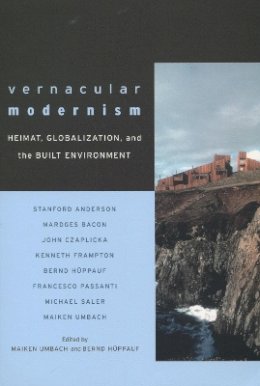7%OFF

Stock image for illustration purposes only - book cover, edition or condition may vary.
Vernacular Modernism: Heimat, Globalization, and the Built Environment
Maiken Umbach (Ed.)
€ 32.99
€ 30.63
FREE Delivery in Ireland
Description for Vernacular Modernism: Heimat, Globalization, and the Built Environment
Paperback. Vernacular Modernism advocates a rethinking of the importance of the vernacular as part of the modernist discourse of place, from art to literature, from architectural to social practice. Editor(s): Umbach, Maiken; Huppauf, Bernd. Num Pages: 280 pages, 38 illustrations. BIC Classification: AM. Category: (P) Professional & Vocational; (UP) Postgraduate, Research & Scholarly; (UU) Undergraduate. Dimension: 5817 x 3887 x 15. Weight in Grams: 454.
Vernacular Modernism challenges the common perception of modern architecture as the example of an internationalism which eradicates local traditions and transforms the globe into a faceless urban sprawl. The essays trace the vernacular in some of modernity's most paradigmatic sites—both real and imagined. They engage in a search for an idiom that mediates between place and space, the vernacular and the abstract in architecture, from its early phase and Hermann Muthesius via LeCorbusier's high modernism, to the contemporary movement of a "critical regionalism."
Product Details
Format
Paperback
Publication date
2005
Publisher
Stanford University Press United States
Number of pages
280
Condition
New
Number of Pages
280
Place of Publication
Palo Alto, United States
ISBN
9780804753432
SKU
V9780804753432
Shipping Time
Usually ships in 7 to 11 working days
Ref
99-1
About Maiken Umbach (Ed.)
Maiken Umbach teaches modern European history at the University of Manchester (UK). She is the author of Federalism and Enlightenment in Germany, 1740-1806 (2000) and German Federalism: Past, Present, Future (2002). Bernd Huppauf is Professor of German at New York University. Among his numerous publications in German and English are Globalization and the Future of German (2004), Skepsis und literarische ... Read more
Reviews for Vernacular Modernism: Heimat, Globalization, and the Built Environment
"The volume's broad geographic scope and inventive exploration of diverse vernacular expressions will convince readers that modernization and modernism were far more open-ended and heterogeneous than previously acknowledged."—H-Net Reviews
